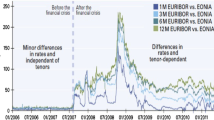Abstract
In this paper we study algorithms for pricing of interest rate instruments using recombining tree (scenario lattice) interest models. The price is defined as expected discounted cash flow. If the cash-flow generated by the instrument depends on the full or partial history of interest rates (path-dependent contracts), then pricing algorithms are typically of exponential complexity. We show that for some models, including product form cash-flows, additive cash-flows, delayed cash-flows and limited path-dependent cash-flows, polynomial pricing algorithms exist.
Similar content being viewed by others
References
Black, F. (1976). The Pricing of Commodity Contracts. Journal of Financial Economics, 3, 167–179.
Black, F., Derman, E. and Toy, W. (1990). A One Factor Model of Interest Rates and Its Application to Treasury Bond Options. Financial Analysts Journal, 46, 33–39.
Black, F. and Karasinski, P. (1991). Bond and option pricing when short rates are lognormal. Financial Analysis Journal, 47, 52–59.
Brace, A., Gatarek, D. and Musiela, M. (1997). The Market Model of Interest Rate Dynamics. Mathematical Finance, 7(2), 127–155.
Clewlow, L. and Strickland, C. (1997). Exotic Options: The State of the Art. International Thomson Business Press.
Cox, J.C., Ingersoll, J.E. and Ross, S.A. (1985). A Theory of the Term Structure of Interest Rates. Econometrics, 53, 365–407.
Dai, Q. and Singleton, K.J. (2003a). Fixed Income Pricing. In: G. Constantinides, R. Harris and M. Stulz (eds.), Financial Markets and Asset Pricing, Vol. 1, Part 2 of Handbook of Economics of Finance, Elsevier B.V., pp. 1207–1246.
Dai, Q. and Singleton, K.J. (2003b). Term Structure Modeling in Theory and Reality. Review of Financial Studies, 16(3), 631–678.
Heath, D., Jarrow, R. and Morton, A. (1992). Bond Pricing and the Term Structure of Interest Rates: A New Methodology for Contingent Claims Valuation. Econometrica, 60(1), 77–105.
Ho, T.S. and Lee, S.B. (1986). Term Structure Movements and Pricing Interest Rate Contingent Claims. Journal of Finance, 41(5), 1011–1029.
Hughston, L. (2000). The New Interest Rate Models: Innovations from Heath-Jarrow-Morton to the Present. Risk Books.
Hull, J. and White, A. (1990). Pricing Interest Rate Derivative Securities. Review of Financial Studies, 3(4), 573–592.
Hull, J. and White, A. (1993). Efficient Procedures for Valuing European and American Path-dependent Options. Journal of Derivatives, 1(1), 21–31.
Hull, J. and White A. (2001). The General Hull-White Model and Super Calibration. Financial Analysts Journal, 57(6).
Jamshidan, F. (1997). LIBOR and swap market models and measures. Finance and Stochastics, 1(4), 293–330.
Longstaff, F.A. and Schwartz, E.S. (2001). Valuing American options by simulation: A Simple Least-Square Approach. Review of Financial Studies, 14(1), 113–147.
Pelsser, A. (2000). Efficient Methods for Valuing Interest-Rate Derivatives. Springer.
Pietersz, R., Pelsser, A. and Regenmortel, M. (2004). Fast Drift Approximated Pricing in the BGM model. Journal of Computational Finance, 8(1), 93–124.
Rebonato, R. (1998). Interest-Rate Option Models: Understanding, Analysing and Using Models for Exotic Interest-Rate Options, 2nd edition. Wiley.
Rebonato. R. (2003). Term-Structure Models: A review. QUARC (QUantitative Research Centre)—Royal Bank of Scotland.
Vasicek, O. (1977). An Equilibrium Characterization of the Term Structure. Journal of Financial Economics, 5, 177–188.
Wilmott, P., Dewynne, J. and Howison, S. (1993). Option Pricing: Mathematical Models and Computation. Oxford Financial Press.
Author information
Authors and Affiliations
Corresponding author
Rights and permissions
About this article
Cite this article
Hochreiter, R., Pflug, G.C. Polynomial Algorithms for Pricing Path-Dependent Interest Rate Instruments. Comput Econ 28, 291–309 (2006). https://doi.org/10.1007/s10614-006-9049-z
Received:
Accepted:
Published:
Issue Date:
DOI: https://doi.org/10.1007/s10614-006-9049-z




